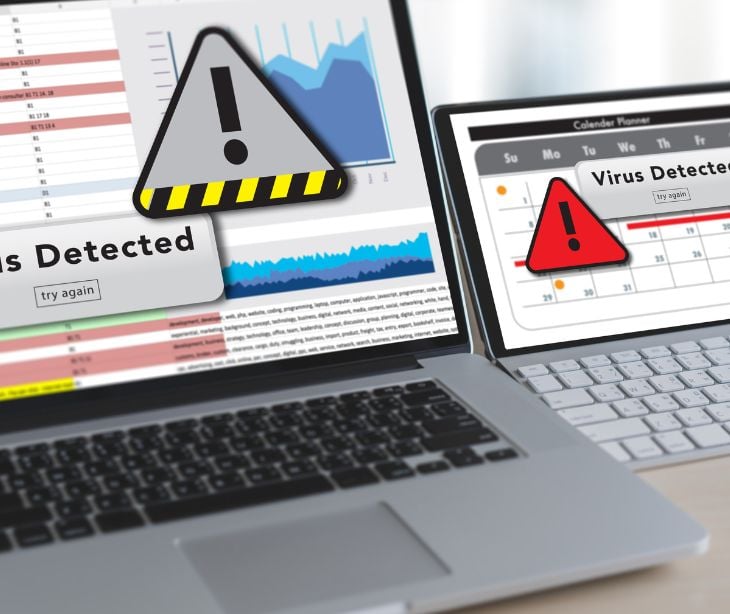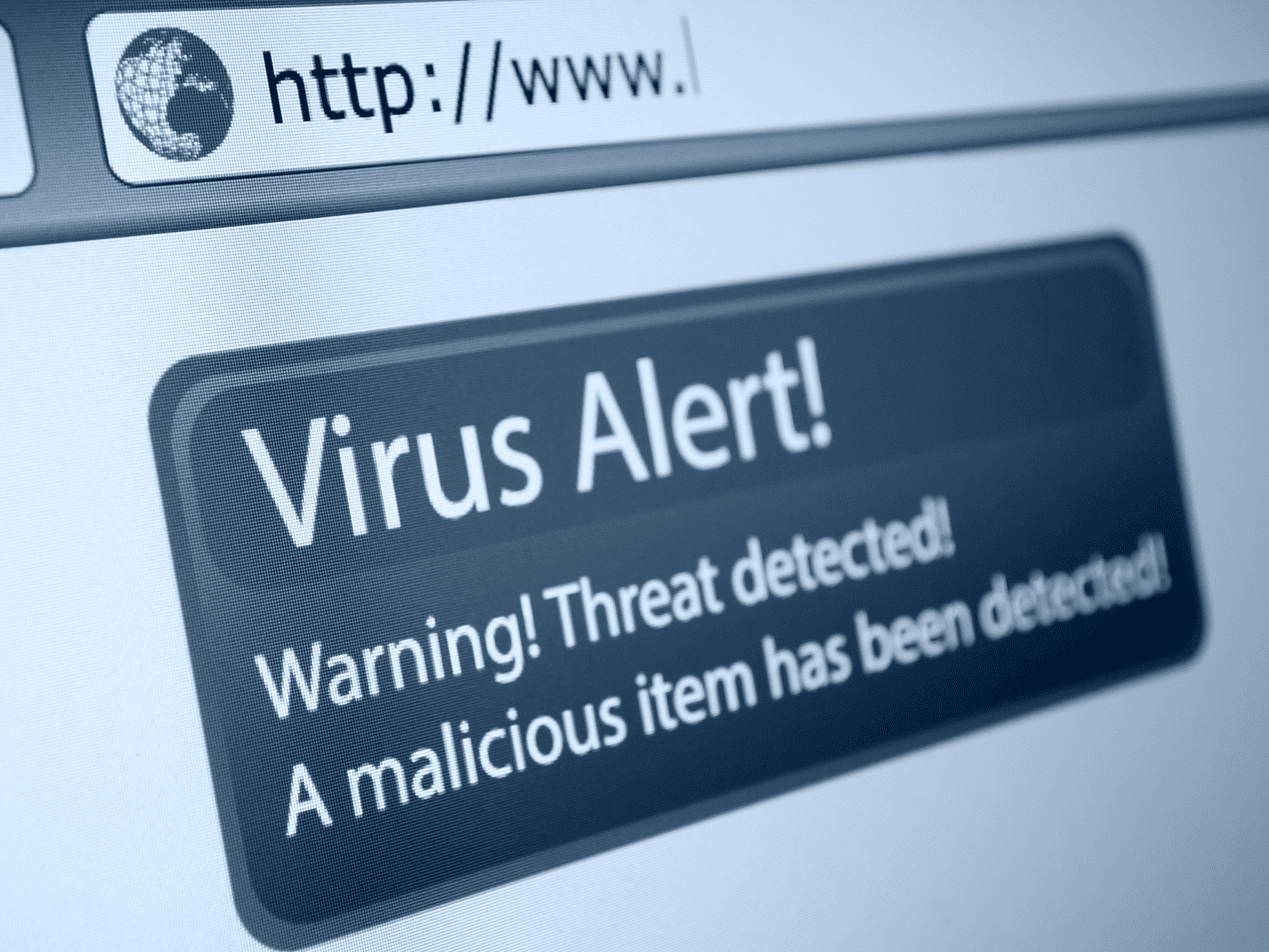
Scareware scams are increasingly common, exploiting unsuspecting users to download malicious software or steal personal information. Strategies, such as installing legitimate antivirus software, learning about common scams, and exercising caution online to reduce the risk of falling victim to scareware scams.
Understanding scareware
Scareware typically begins with a deceptive message, often in a pop-up window, altered text, or a misleading email. The defining feature of scareware is its use of alarming methods, such as frightening individuals with the prospect of computer viruses or legal consequences, to compel them to respond immediately.
These misleading messages often appear authentic, utilizing the branding of reputable companies or disguising themselves as system alerts or reports from antivirus programs.
Read more: What is scareware?
Protection from scareware scams
Defending against scareware scams requires a combination of proactive steps and cautious behaviors.
Legitimate antivirus software
Install and update reliable antivirus software to protect against scareware scams. It offers real-time protection by detecting and removing potential threats before harm is caused.
Educate yourself
Stay informed about the latest scam techniques and tactics used by cybercriminals. By familiarizing yourself with these indicators, you can quickly identify and avoid potentially harmful situations.
Exercise caution
Exercise caution when encountering links and pop-ups, especially those claiming to offer free antivirus software or alarming virus scan reports. Instead, close the pop-up window or the browser tab. Avoid clicking on suspicious links in emails, social media posts, or websites that seem untrustworthy.
Unsolicited tech support
Tech support from reputable companies will never initiate contact with you unless you have specifically contacted them. If you receive an unsolicited call or pop-up message claiming to be tech support, remain skeptical. Do not provide personal or financial information and avoid granting remote access to your device. Instead, independently verify the authenticity of the contact through official channels before taking any action.
Regular backups
Regularly backing up your data is essential in protecting yourself from potential data loss caused by scareware scams or other cyber threats. By creating backups, you can restore your important files and minimize the impact of any potential malware attacks. Ensure that your backups are stored offline or in trusted cloud storage services.
Use ad blockers and malware protection extensions
Utilize ad blockers and malware protection extensions in your web browser to minimize the risk of encountering malicious advertisements or unintentionally clicking on scareware-related content. These tools can detect and block potentially harmful scripts, ads, and pop-ups, providing additional protection against scareware scams.
Update your software
Maintaining up-to-date operating systems and software is crucial for staying protected against scareware scams and other cyber threats. Regularly install the latest updates and security patches for your operating system, web browsers, and other software applications. These updates often include essential security fixes that address vulnerabilities that cybercriminals may exploit.
Strengthen your passwords
Strong passwords are an integral part of protecting online accounts from unauthorized access. Create unique, complex passwords that combine letters, numbers, and special characters. Consider using a password manager to securely store and generate strong passwords for your various accounts.
Be mindful of public Wi-Fi networks
When using public Wi-Fi networks, exercise caution to protect yourself from potential scareware scams and other cyber threats. Public Wi-Fi networks can be insecure, making it easier for cybercriminals to intercept sensitive information transmitted over these networks. Avoid accessing sensitive accounts or conducting financial transactions when connected to public Wi-Fi.
Trust your instincts
If you encounter a situation that seems suspicious or too good to be true, trust your instincts and verify the information independently. Take the time to research and validate claims before taking any action. Exercising caution and maintaining a healthy level of skepticism can minimize the risk of falling victim to scareware scams.
See also: HIPAA Compliant Email: The Definitive Guide
In the news
In a far-reaching scheme spanning 60 countries, three men were indicted for allegedly selling victims $100 million worth of bogus software that purported to fix nonexistent system problems. According to the Chicago FBI field office, the federal indictment targets a Cincinnati area man and two others believed to be living abroad. The charges allege that the defendants used fake advertisements on legitimate companies' websites to deceive internet users into believing their computers were infected with malware or had other big errors, inducing them to purchase scareware software products with limited or no ability to remedy the nonexistent defects.
This scheme, considered one of the fastest-growing types of internet fraud, involved Bjorn Daniel Sundin and Shaileshkumar P. Jain, who owned and operated Innovative Marketing, Inc. (IM), a company registered in Belize with a subsidiary in Kiev. The company allegedly lured users to a scareware site that mimicked operating system warnings, prompting users to download fake software. Despite appearing to close after a Federal Trade Commission lawsuit, the impact of this fraudulent activity proves the ongoing threat of scareware scams.
FAQs
What is scareware and how can it affect the healthcare industry?
Scareware is fake security software that tricks users into thinking their system is infected. In healthcare, it can disrupt operations, compromise patient data, and lead to financial losses.
How is scareware different from other types of malware like viruses or ransomware?
Scareware uses fake alerts to scare users into buying bogus software, unlike viruses that spread or ransomware that locks data for ransom.
What are some common indicators that a computer system in a healthcare setting might be infected with scareware?
Signs include frequent fake virus warnings, system slowdowns, prompts to buy software, and unauthorized charges for security services.
What measures can healthcare organizations take to protect themselves from scareware attacks?
Protect against scareware by training staff, using reliable antivirus software, keeping systems updated, and employing strong network security.
Subscribe to Paubox Weekly
Every Friday we'll bring you the most important news from Paubox. Our aim is to make you smarter, faster.



